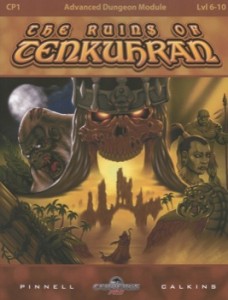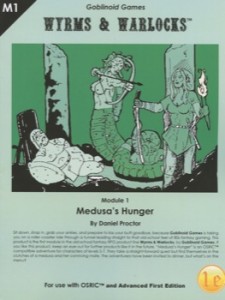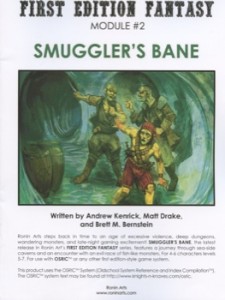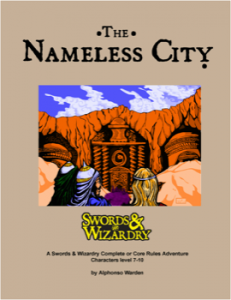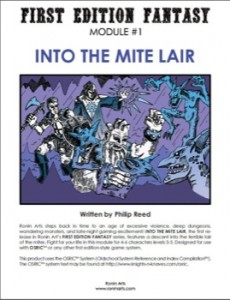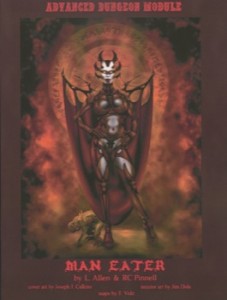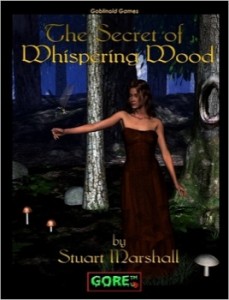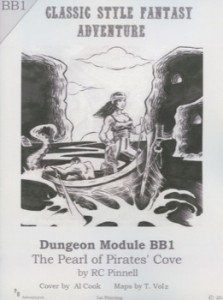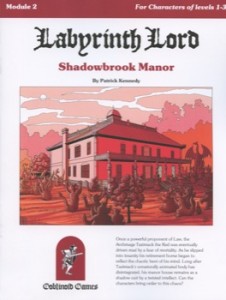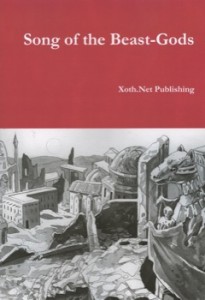Deep in the jungles sits the ruins of a mighty city. It’s king and his elite 6 would scour the jungles for hidden treasures and amassed a horde before disaster struck and their city was laid to ruin. Will you dare to explore the Ruins of Tenkuhran?
I’ve got a problem with this module but I don’t know what it is. Something is very much rubbing me raw. The product starts out with a two-page backstory piece of fiction. In my experience that’s never a good sign. Vampire books start that way. I don’t want epic. I don’t want a history lesson, that’s MERPs domain. I want an OSR module and OSR modules don’t make me wade through two pages of a story that has no real relevance to the adventure at hand. This is a recurring theme over the module: it’s verbose in places that don’t need it and terse in places that need extra help.
Cite! Page 3 has notes for the DM. It includes “Classes from the UA text should be excluded unless you choose to allow them.” and “if a paladin is among the party the inclusion of an assassin should not be allowed.” I’m not sure exactly how to classify this type of advice. I differentiate between this type and the “how to run checking for traps in a game without thieves” sort of advice. Perhaps the later is more of an explanation of a play style and the former is … more directly arbitrary? It’s certainly more campaign specific opinion than fact, and for some reason comes over as preachy. The module is rife with this sort of advice and I groan every time i see it.
Cite! The myths rumors and legends table, with 6 entries, actually contain a small story. In essence you can think of it as a small six sentence paragraph with each sentence being a different rumor. This leaves much of the table in an awkward state. Entry #6 reads “Now, generations later, the ruins have all but nearly forgotten, left to decay back in to the earth as the jungle has expanded and crept upon it, claiming it.” Arg! Out of context!
Cite! Repeating, perhaps verbatim, the description of two two different orc villages in two separate places. Two two orc villages get two different descriptions, and the descriptions of both villages seem to be the same. Just to be clear, that;s two location, each of which has two descriptions (abandoned and not.) This is just wasted space.
The adventure proper resembles a wilderness journey, exploration of surface ruins, and a small crawl. The wilderness adventure features a road and an overland jungle trail. The road is disappointing; It’s really just four encounter located along the road. Further, it’s laid out strange. There’s a introductory paragraph describing the encounter lead-in, then a “numbered encounter” along with monster stats. This means that the text of the encounter description, verbose as it is, occurs BEFORE the number for that encounter. Following the number is the monster stats. This seems to be a non-intuituive way to lay things out. All I can think is that this is meant to be some linear plot-type road-trip arc. The layout makes some sense in that context, or rather, at least I can rationalize it in that manner.
Next comes one of the most confusing parts of the adventure for me. There is an orc village. The DM has two options for running it: inhabited or not. If it’s NOT inhabited then the party will encounter about 24 8HD ghoul-apes living in the huts. If it IS inhabited then the party meets good orcs. The ghoul-ape encounters are going to be very rough at the recommended levels. I don’t necessarily have a problem with that, but a party which is not careful is going to hit a TPK before the exploration really begins. I’m not really sure why the good orcs exist. Why not humans? Humanoid monsters are overused in D&D, IMHO, and I would much prefer to see bestial jungle tribesmen and same the ‘monster’ label for the really strange stuff … like the ghoul apes. This is where things get confusing: there are then two more descriptions for orc villages, one abandoned and one inhabited. Much of the text is the same, and I mean copy/paste same, and the setup is the same. I’ve reread the entries several times over the last two days and I can’t figure out what’s going on. It feels like there are supposed to be at least two separate orc villages (the map shows yet another village further on in to the jungle, quite a ways off. I don’t think it’s one of these two villages.) but I can’t figure out how they are related or where they are ini relation to each other. I don’t THINK they are the ‘third’ village; that village may have been overrun by evil, causing the orcs to migrate to their current village location(s)? Anyway, there’s a village of friendly orcs that can used as a base, and a village of ghoul-apes that will rip almost any party to shreds. The organization of them could be much much clearer.
The ruins of the city, near the village(s), are one of the better parts of the adventure. It reminds me of one of the more interesting parts of third and fourth edition D&D. 3E advised that encounter locations be interesting, and perhaps fantastic. 4E pretty much cemented that in it’s published modules. Fights occur in crumbling ruins (DEX checks!) on misty clouds (balance to not fall through!) or in a kitchen with boiling pots (kick a hot soup pot in someones face!) This sort of thing is one of my favorite parts of some of the older adventures. Some random orc would use the goat-leg he was eating as a weapon when the party burst in on him, or so on. Many of the encounters in the surface ruins feel like these little set-peice sort of things. To be sure in many cases it’s because of the monster selections. Harpies in tree singing. Plant-men groves with with animated tree allies, a hag in a crumbling tower, and so on. Lots of monsters with special effects. I like those sorts of things. It adds the variety to an adventure that is needed to keep it from becoming a straight-on boring hack-fest. The 13 or so ruins encounters are on the verbose site of things, with on three or so per page because of their exposition, however they are certainly an interesting assortment of non-humanoid encounters and I approve heartily. It’s almost exactly what I’m looking for in a wilderness ruins sort of exploration. I might have preferred more whimsy and some weird things to play with (magic fountains rule!) but the encounters are pretty good.
From this set of ruins the party will discover another set further in to the jungle, hopefully, and journey to them. The surface ruins in that location are QUITE a bit sorter, really just a monster notation. For example “Mantis, Giant (HP70) This gigantic insect (10HD) is generally benign unless assaulted.” That’s a pretty good encounter description in my book. Maybe just a sentence more on the location or what the mantis is doing, but the length is almost correct. The dungeon beneath the ruins are a deathtrap. In quasi-planer, so each hour each magic item the party has needs to make a save or become less magical/lose a plus. In addition, all spells cast much first overcome a pervasive Dispel Magic aura at 15th level. Ouch! The lose a plus effect is going to be a pain to run and slow the game down. The Dispel Magic effect is very powerful and is going to make the encounters inside all the more tough. The crawl is mostly linear and the descriptions remind me of the Tomb of Horrors. Each room has a detailed description and lots of carvings/curtains/features. In many cases the room descriptions are too verbose for my tastes. Much of the complex is not really interesting and is just an excuse to have a rom with monsters in it. The notable exception is one of the last, which contains a doorway to the throne room of an evil goddess of death. Good Luck kiddies! Sometimes the big red shiny button does NOT lead to a stat increase …
The organization and layout of this could have been much better; having to reread lengthy PAGES to try and figure out what is going on is not indicative of ‘clear.’ The product is also much more verbose than I generally like. The first set of ruins is generally well done but the second needs just a touch more detail. The dungeon and the ape-ghoul village are both VERY deadly. I wish there was more whimsy, more weird things, and more for the party to play with; there’s a lot of hacking and not much exploration.
This is available on DriveThru.
https://www.drivethrurpg.com/product/86973/The-Ruins-of-Tenkuhran?affiliate_id=1892600

